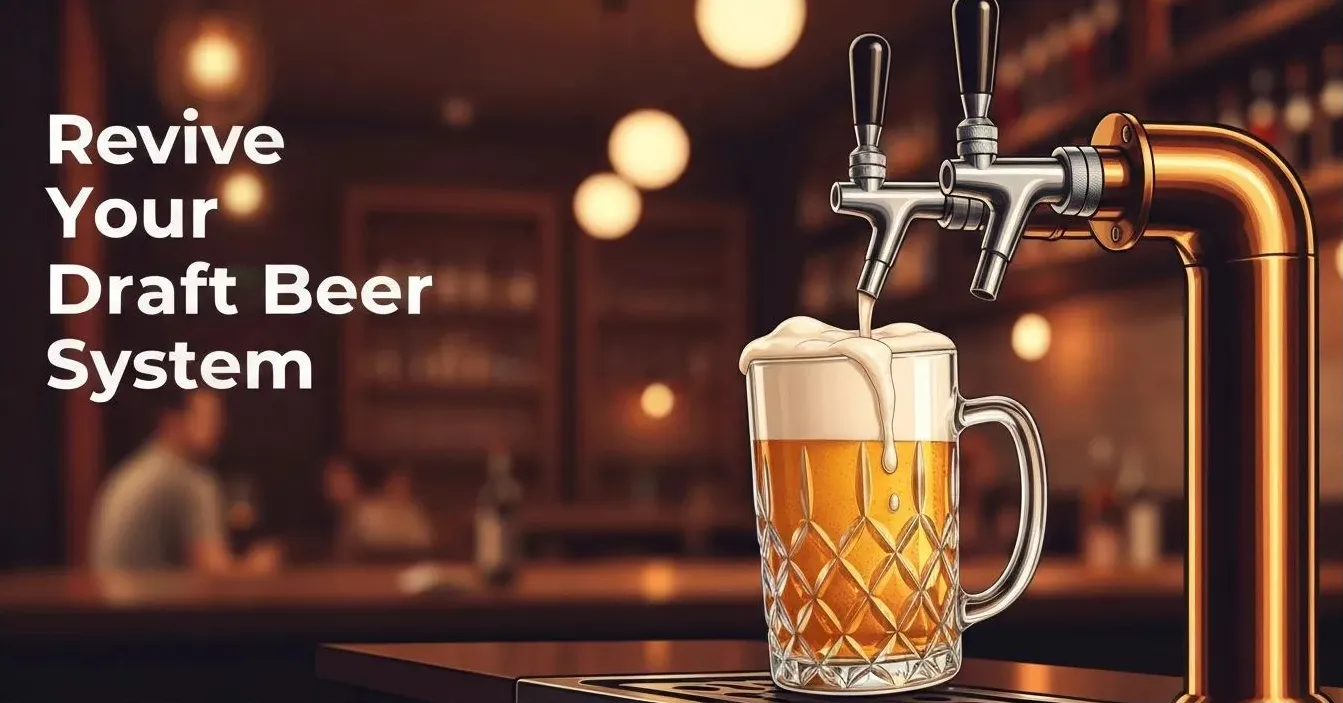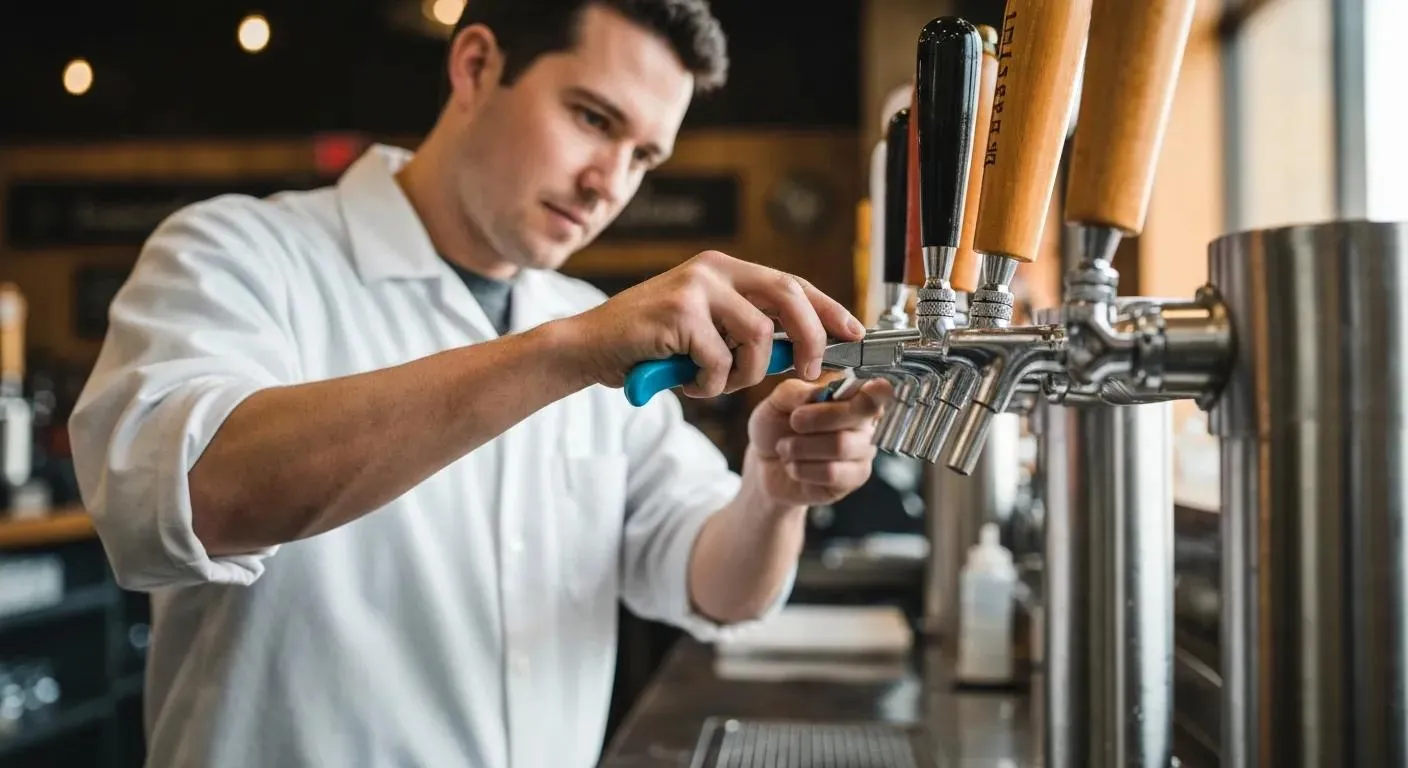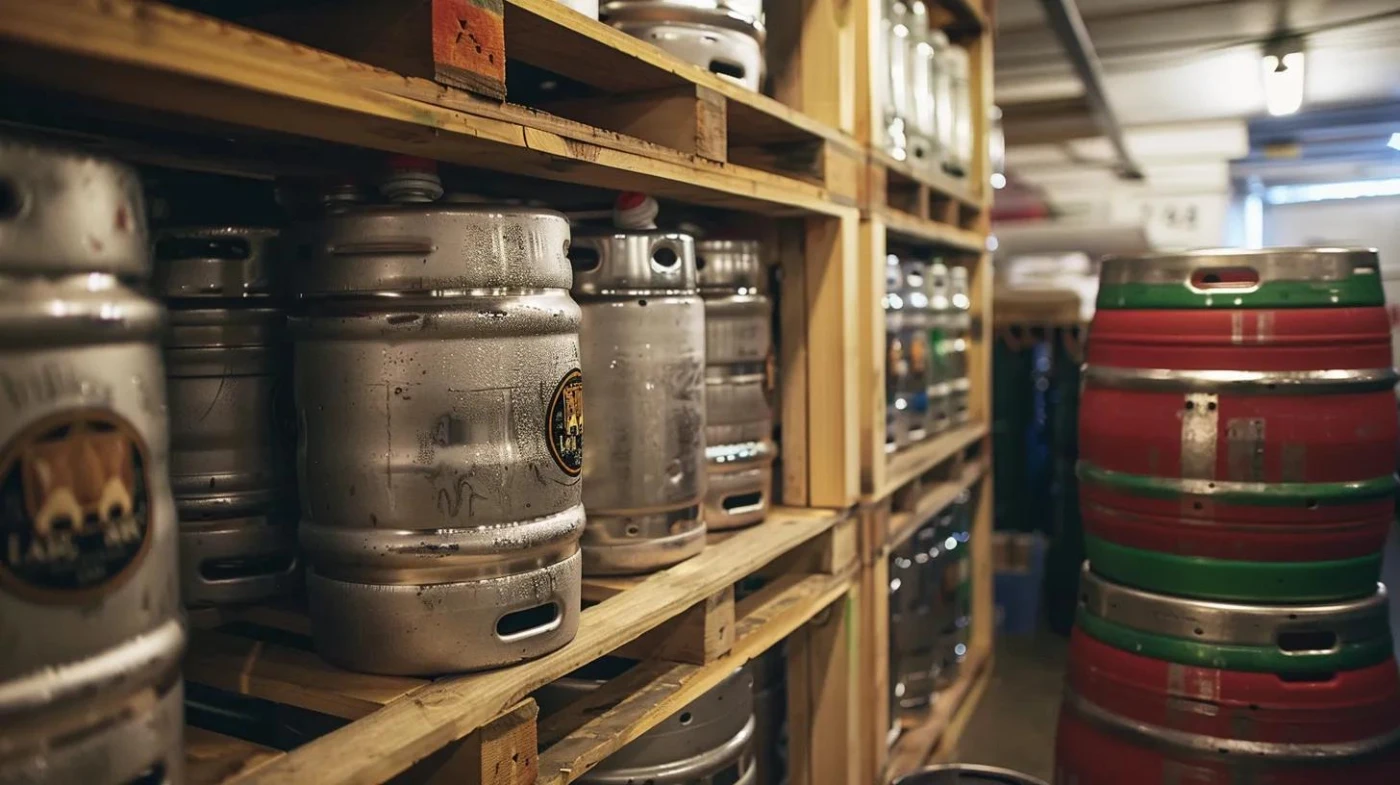Troubleshooting Your Bar: Common Issues in Beer Tap Systems

Draft beer systems combine equipment, chemistry, and handling to deliver consistent pints; when any part fails, pours suffer and businesses lose revenue and reputation.
This guide explains the most common issues in beer tap systems — foam, flatness, slow or no pour, off-flavors, and maintenance gaps — and gives clear diagnostics and practical fixes that staff can apply immediately. You will learn why temperature, CO₂ pressure, and line cleanliness control carbonation and head, how mechanical faults disrupt flow, and which checks quickly isolate each root cause.
The article maps actionable steps (what to check and how), prevention tactics (cleaning schedules, pressure balancing, refrigeration), and when to escalate to professional services.
Coverage includes foam causes and quick remedies, flat-beer troubleshooting, no-pour diagnostics, off-flavor origins and prevention, plus a maintenance roadmap with recommended frequencies.
Why Is My Beer Tap Pouring Foamy and How Can I Fix It?
Excessive foam occurs when CO₂ comes out of solution too rapidly or when nucleation sites in the flow path increase gas release, producing large, unstable head, excessive beer waste, and agitation during keg handling are primary mechanisms that increase nucleation and foam stability, harming pour yield and customer experience.
Properly identifying which mechanism is active lets staff apply precise fixes that reduce waste and restore proper head retention.
Below are targeted explanations of each common cause followed by quick diagnostic steps and remedies that can be performed on-site.
What Causes Foamy Beer in Draft Systems?
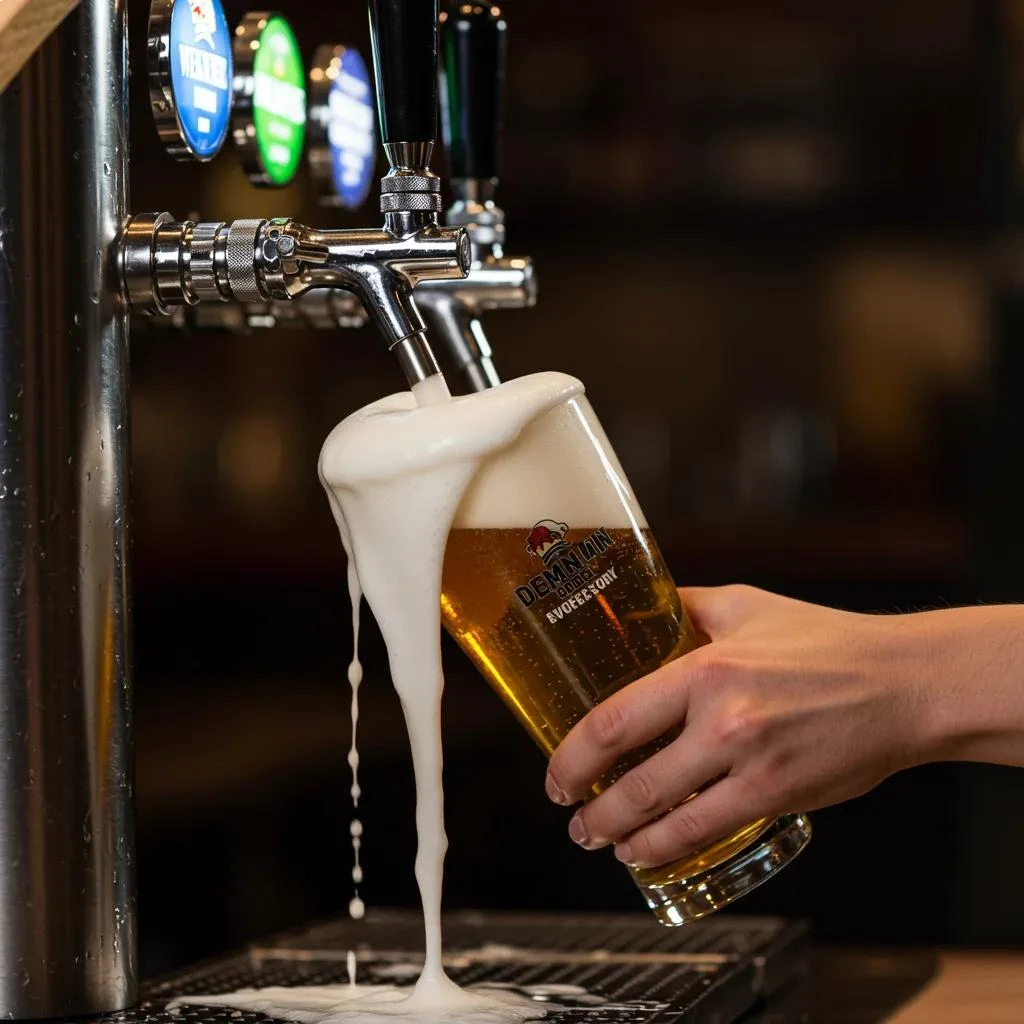
Foamy beer in draft systems is typically caused by four drivers: warm beer or lines, over-pressurization, dirty or contaminated lines, and mechanical agitation from rough handling.
Warm beer lowers CO₂ solubility so dissolved gas escapes as foam; over-pressure forces gushers at the faucet; biofilm in lines provides nucleation sites; and bumped kegs or long transport time introduces turbulence.
To diagnose, check serving temperature first, then observe whether foam appears immediately on tapping a fresh keg or develops over time — immediate foam often indicates pressure or temperature, while progressive foam suggests contamination. Identifying the pattern narrows down whether to adjust temperature, regulate gas, or clean lines next.
Before the next section we’ll examine how temperature specifically alters foam behavior and what checks to perform on refrigeration systems and lines.
How Does Temperature Affect Foam in Beer Taps?
Serving temperature controls CO₂ solubility: colder beer holds more dissolved CO₂, reducing foam, while warm beer releases gas quickly and creates excessive head.
Most ales and lagers served from draft systems are best kept near refrigerator temperatures appropriate to style; warm storage or poorly maintained glycol circuits allow line or keg warming that triggers foaming.
Quick checks include verifying keg and tower temperatures with a thermometer and feeling for warm spots along lines and the tower; feel and readouts that show elevated temperatures point to refrigeration or insulation failures. Correcting temperature typically stabilizes pours immediately, but persistent heat-related foaming may require refrigeration servicing or improved line insulation.
How Can CO₂ Pressure Lead to Excessive Foam?
CO₂ regulator settings that are too high force rapid gas release at the faucet, causing gushers and unstable head; conversely, sudden pressure spikes from tank changes can create transient foaming.
The regulator’s role is to balance gas to maintain carbonation and drive flow without over-pressurizing the keg; improper setpoints upset this balance and produce foam.
To troubleshoot, check regulator gauges for consistent output pressure, confirm correct setpoint for the beer style and system length, and slowly lower pressure in small increments while testing pours.
Safe adjustment minimizes foam without risking flatness; if pressure readings fluctuate or regulators fail to hold, component replacement or professional balancing is advised.
Why Do Dirty Beer Lines Increase Foam?
Dirty beer lines develop biofilms, yeast residue, and particulate buildup that act as nucleation sites, trapping CO₂ and producing excessive foam even when temperature and pressure are correct.
This mechanism also contributes to off-flavors and inconsistent carbonation perception because trapped gas escapes prematurely in the faucet.
Regular line cleaning removes residues and restores smooth interior surfaces that reduce nucleation and improve head control. For venues experiencing recurring foam despite correct temp and pressure, professional beer line cleaning services can remove entrenched biofilm and confirm line integrity to prevent repeat issues.
Intro to the table below: the table summarizes foam causes and corrective actions for quick reference and staff training.
What Are Quick DIY Fixes for Foamy Beer?
Immediate steps can reduce foam while you diagnose the root cause, restoring service quality quickly and minimizing waste. Start with simple checks and temporary adjustments that are safe to perform without specialized tools.
Check keg and line temperature and move kegs to proper refrigeration if warm.
Verify and adjust CO₂ pressure down in small steps, testing pours after each change.
Tighten or reseat the coupler, purge the faucet, and flush lines briefly to dislodge trapped gas.
These quick fixes often stabilize pours for the short term, but recurring foam after these steps indicates deeper issues like persistent contamination or system imbalance that require professional cleaning or balancing.
What Are the Common Causes of Flat Draft Beer and How Do I Troubleshoot Them?
Flat draft beer results when CO₂ is lost or unable to release properly at the point of pour, typically driven by low brewery pressure, leaks introducing air, or line contamination that alters perception of carbonation.
Diagnosing flatness involves stepwise checks of gas pressure, leak detection, and line/faucet cleanliness so you can correct the specific failure without unnecessary component replacement.
Below we break down common causes, simple fixes to restore carbonation, and signs indicating it’s time for professional repair or system inspection.

How Does Low CO₂ Pressure Cause Flat Beer?
Low CO₂ pressure reduces the force pushing beer through the lines and the maintenance of dissolved carbonation, so beer tastes flat and pours slowly.
Regulators may drift, tanks can be depleted, or setpoints may simply be too low for system length and dispense configuration.
Check regulator gauge readings and gas tank pressure, then raise pressure to the recommended setpoint while observing change in carbonation and pour rate. If CO₂ levels drop rapidly after adjustment, investigate regulator leaks or tank issues; persistent low pressure despite correct tank levels suggests regulator replacement or professional service.
Can Leaks in the Draft System Lead to Flat Beer?
Leaks allow CO₂ to escape and oxygen to enter, reducing carbonation and introducing off-flavors; common leak points include couplers, connectors, and seals.
Detect leaks with a soap solution applied to fittings or by monitoring unexpected pressure drops on the regulator gauge.
Typical fixes are tightening fittings, replacing worn O-rings and seals, or reinstalling couplers; if leaks persist or are inside inaccessible components, professional diagnostics will identify the fault and recommend repair or replacement.
Intro to the table below: the following table maps flat-beer symptoms to checks and fixes for staff to follow when troubleshooting carbonation loss.
How Do Dirty Faucets and Lines Affect Beer Carbonation?
Residues in faucets and lines change the beer’s surface interactions so head retention and carbonation perception are reduced, making beer seem flat.
Salts, hop residues, and biofilms alter nucleation and can also trap CO₂ leading to uneven pours.
Routine faucet disassembly, inspection, and cleaning remove deposits and restore proper flow; persistent taste or carbonation issues after cleaning indicate deeper line contamination or line material degradation that may require replacement or professional remediation.
What Are Simple Steps to Fix Flat Beer at the Tap?
- Check CO₂ Pressure: Verify regulator and tank pressures and adjust to recommended setpoint.
- Inspect for Leaks: Perform a soap test on connections and listen for hissing or pressure drops.
- Clean Faucet and Lines: Flush and clean to remove residues, then test pour for improvement.
These steps usually resolve flatness within minutes to an hour; if not, escalate to professional diagnostics to avoid repeated customer complaints.
When Is Professional Repair Needed for Flat Beer Problems?
Professional repair is needed when flatness persists after standard checks, when regulators or multi-tap balancing are complex, or when system design prevents proper pressure distribution.
Complex systems, frequent pressure drift, or repeated leaks point to systemic issues where custom draft system installations or professional diagnostics improve long-term performance.
Scheduling a professional assessment prevents recurring quality problems and helps select the right upgrades for consistent carbonation across taps.
Why Is My Beer Tap Not Dispensing or Pouring Slowly?
No-pour or slow-pour issues break service and require quick, prioritized troubleshooting so bars and restaurants can restore pints with minimal interruption.
Common causes include empty kegs or depleted gas, kinked or blocked lines, faulty couplers or faucets, and regulator failures.
This section gives immediate checks to identify supply problems, mechanical obstructions, and pressure irregularities, plus emergency steps to get taps back to service and guidance on when to call pros for repair or custom installation to prevent recurring flow issues.
What Causes Slow or No Pour in Draft Beer Systems?
Slow or no pour can stem from empty kegs, closed or blocked valves, kinked lines restricting flow, frozen or iced lines, or faulty regulators and couplers.
Each cause has unique diagnostics: tapping a fresh keg rules out emptiness, visual inspection finds kinks, and feeling for frozen sections reveals temperature problems.
By isolating the category — supply, mechanical blockage, or pressure — staff can choose the appropriate fix without replacing the wrong part.
How Do Empty Kegs or Gas Supply Issues Affect Pouring?
An empty keg or exhausted CO₂ tank provides no driving force for beer movement; similarly, under-pressurized gas fails to push beer through long or high-resistance runs.
Check keg level by weight or tapping a test pour, confirm gas tank pressure and regulator output, and perform safe keg swaps following standard procedures to avoid agitation.
Ensuring spare tanks and trained staff reduces service interruptions during busy shifts.
Can Kinked or Blocked Beer Lines Stop Beer Flow?
Physical obstructions like kinks, collapsed tubing, or particulate blockages impede flow and cause slow pours or complete stoppage; bad routing with tight bends increases resistance.
Visually inspect exposed lines, squeeze along runs to detect soft spots, and verify recommended line lengths and diameters for the system configuration.
Temporary rerouting or replacing damaged sections restores flow; long-term prevention requires proper installation and occasional line replacement.
How Do Pressure Settings Influence Beer Flow Rate?
Pressure settings determine the force driving beer through the system and must be balanced against line resistance and serving conditions; too low causes slow pours, too high causes foaming.
Single-tap systems differ from multi-tap manifolds, so setpoints must account for system length and type.
Monitor regulator stability and perform incremental adjustments while testing flow rate to establish reliable setpoints for consistent pours across service periods.
What Are Immediate Troubleshooting Steps for No Pour?
- Verify Keg and Gas: Confirm keg is full and gas tank reads adequate pressure.
- Check Coupler and Faucet: Ensure coupler is correctly engaged and faucet opens.
- Inspect Lines: Look for kinks or frozen sections and flush briefly if needed.
These steps restore many common service interruptions quickly; if these do not resolve the issue, escalate to professional repair for diagnostic testing.
When Should I Contact Rennys Draft Solutions for Pour Problems?
Call a professional when no-pour issues persist after frontline troubleshooting, when regulators or manifold balancing require calibrated service, or when system design is causing repeated flow problems.
Rennys Draft Solutions offers custom draft system installations and diagnostic and repair services that reduce recurring pour failures and improve long-term reliability.
Engaging professionals is appropriate when system-level fixes or custom installation choices are needed to prevent repeat incidents.
How Do Off-Flavors Develop in Draft Beer and How Can They Be Prevented?
Off-flavors in draft beer arise from biological contamination, chemical reactions, or equipment interactions that introduce sour, metallic, or cardboard notes.
Microbial growth, oxidized beer, and residues from cleaning chemicals are common mechanisms that degrade flavor and harm customer perception.
Preventing off-flavors depends on disciplined cleaning, correct storage and handling, and timely component replacement; the following subsections explain causes, microbial impacts, cleaning importance, replacement triggers, and serving best practices.
What Causes Off-Taste in Draft Beer Systems?
Off-tastes like sourness, metallic notes, or papery/cardboard flavors come from different sources: sour indicates bacterial contamination, metallic suggests corroded fittings or oxidized beer, and cardboard often means oxidation or old keg stock.
Matching taste descriptors to likely sources helps narrow diagnostics quickly: taste tests combined with line and keg inspection point to contamination versus storage issues.
Early isolation and targeted cleaning or replacement prevent spread to other taps.
How Does Bacterial Growth Affect Beer Flavor?
Bacterial growth forms biofilms that break down beer sugars and produce sour, phenolic, or other undesirable metabolites that taint flavor.
Biofilms also protect microbes from brief flushing and can repopulate lines quickly if not removed by proper cleaning methods.
Addressing bacterial contamination requires thorough chemical cleaning and sometimes professional remediation to fully remove entrenched biofilm and restore stable taste profiles.
Why Is Regular Beer Line Cleaning Essential to Prevent Off-Flavors?
Scheduled line cleaning removes biofilm, yeast, and hop residues that cause off-flavors and maintain consistent carbonation and head retention.
Industry practice supports regular cleaning intervals tied to volume and product type to avoid taste drift and customer complaints.
Professional cleaning can achieve deeper remediation than DIY flushing, reducing waste and protecting brand quality in high-volume venues.
Intro to the table below: the maintenance table outlines recommended tasks, frequencies, and the business benefit so operators can adopt a practical maintenance program.
The presence of brewery biofilms in draft lines poses a significant risk of contamination, potentially harboring spoilage bacteria that can compromise the quality and flavor of the final beer product.
These microbial communities can lead to substantial financial losses and downtime for cleaning in retail settings, underscoring the critical need for vigilant monitoring and management of draft beer systems.
When Should Beer Lines Be Replaced to Avoid Off-Flavors?
Lines should be replaced when cleaning no longer restores flavor, when material shows clouding or damage, or when line age and heavy contamination risk persistent off-tastes.
Typical replacement timelines vary by usage, but visible wear, discoloration, or recurring contamination after professional cleaning are clear triggers for replacement.
Selecting compatible materials and keeping records of line age aids lifecycle planning.
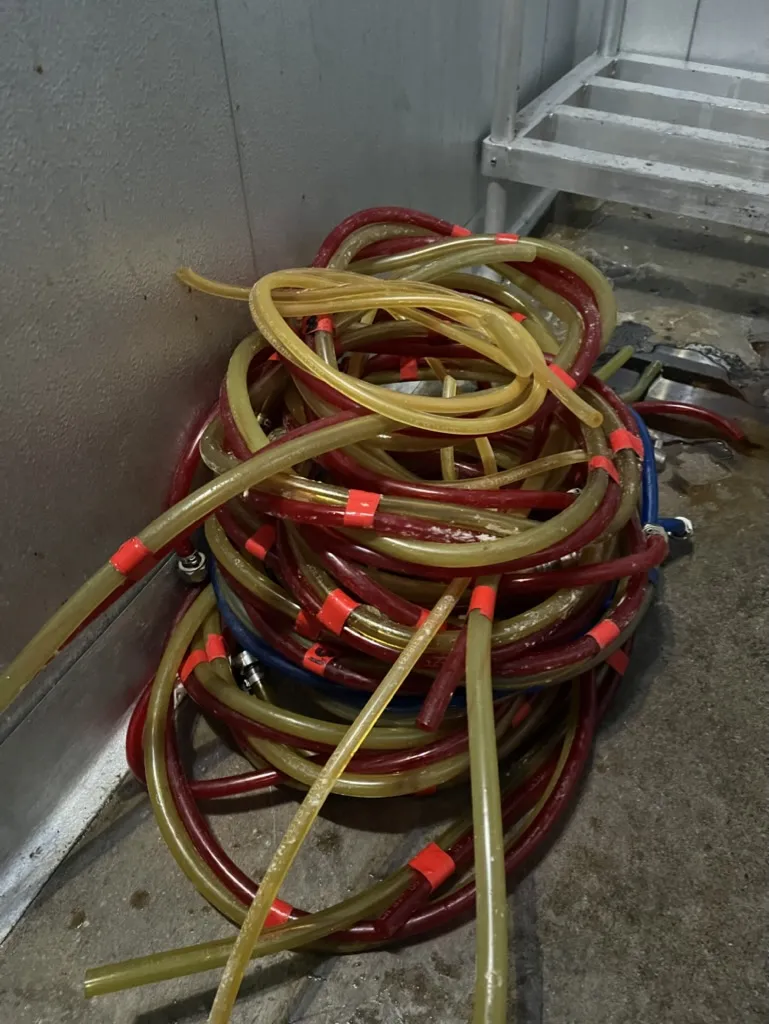
What Are Best Practices for Storing and Serving Draft Beer?
Proper storage and serving reduce contamination and carbonation loss: rotate kegs FIFO, maintain recommended keg temperatures, handle kegs gently to avoid agitation, and purge lines correctly before and after service.
Correct tapping procedures and staff training ensure reduced oxygen pickup and consistent pours.
Implementing these practices standardizes quality and reduces the need for corrective interventions.
How Can Professional Cleaning Services Improve Beer Taste?
Professional services use recirculation cleaning, appropriate detergents, and inspection tools to remove biofilm, sanitize lines, and verify results, delivering measurable flavor improvements and reduced waste.
For recurring contamination or high-volume venues, professional scheduling and documentation improve compliance and product quality.
Rennys Draft Solutions provides professional beer line cleaning services and maintenance plans, including a "Brewer Approved" distinction for venues that meet recommended quality standards.
Key benefits of professional cleaning
- Thorough Biofilm Removal: Deep cleaning methods remove entrenched residues.
- Consistent Results: Standardized processes reduce variability across taps.
- Documentation: Clean records support quality control and compliance.
The establishment of clear industry standards for draft beer dispensing, encompassing hygienic design, installation, and maintenance, is crucial for ensuring product quality and preventing contamination. These standards, developed by expert panels and industry collaborations, provide a framework for best practices that can be adopted by breweries and retail establishments alike.
What Are the Key Maintenance Practices to Keep Draft Beer Systems Running Smoothly?
Proactive maintenance combines scheduled cleaning, temperature management, pressure balancing, leak detection, and thoughtful system design to prevent the majority of draft system problems.
Regular tasks keep beer tasting fresh, improve pour rates, and limit waste and downtime.
Below are specific practices, recommended frequencies, and how custom installation and professional plans reduce recurring issues.
How Often Should Beer Lines Be Cleaned for Optimal Quality?
Industry-guided baseline cleaning is bi-weekly for many commercial operations, with higher-frequency cleaning for high-volume lines, fruit beer taps, or lines serving hazy or unfiltered products.
Cleaning intervals depend on product type and traffic; maintaining a cleaning log improves accountability and helps detect trends that suggest more frequent service. We recommend every 14 or 28 day cycles. Regular cleaning preserves flavor, reduces foam and flatness issues, and protects brand reputation.
What Role Does Temperature Control Play in Draft System Maintenance?
Consistent temperature from keg to faucet prevents CO₂ loss and flavor changes; faulty glycol systems, poor insulation, or inconsistent refrigeration create warm spots that drive foam and off-flavors.
Maintenance includes monitoring reservoir levels, inspecting coils and pumps, and confirming temperature at the keg and tower.
Alarms or routine checks reduce the risk of unnoticed failures that quickly impact pours and customer experience.
How Should CO₂ Pressure Be Balanced for Consistent Beer Quality?
Balancing CO₂ requires selection of correct regulator setpoints for the system configuration and ongoing verification under load; multi-tap systems often need staged regulators or balancing valves to distribute pressure evenly.
Routine gauge checks, leak tests, and observing pour behavior after adjustments ensure carbonation and flow meet expectations.
Proper balancing prevents foam, flatness, and uneven pours across taps.
What Are Signs of Leaks and How Can They Be Fixed?
Signs of leaks include audible hissing, unexplained pressure drops, and sudden flatness or CO₂ depletion, emptied gas cylinder tanks is another sign.
Use a soap test on fittings, monitor regulator gauge stability, and inspect couplers and seals visually.
Simple fixes include tightening connections and replacing O-rings; recurring leaks or hard-to-reach failures should be addressed by professionals to ensure long-term reliability.
How Does Custom Draft System Installation Prevent Common Issues?
Thoughtful design choices — correct line length and diameter, proper regulator sizing, reliable refrigeration, and accessible routing — minimize foam, flatness, and flow issues before they appear.
Custom installation aligns system components with venue needs, reducing pressure conflicts and simplifying maintenance.
Investing in the right layout lowers total cost of ownership and improves service consistency.
Why Choose Professional Maintenance Services Like Rennys Draft Solutions?
Professional maintenance delivers predictable quality through scheduled cleaning, expert balancing, and targeted repairs; Rennys Draft Solutions offers custom draft system installations, professional beer line cleaning services, and a Brewer Approved distinction to help venues maintain high standards.
Working with experienced technicians reduces downtime, limits waste, and protects brand reputation through reliable draft performance.
Maintenance priorities summary
- Regular Cleaning: Prevents contamination and foam.
- Temperature Control: Maintains carbonation and flavor.
- Pressure Balancing: Ensures consistent pours across taps.
These practices together form a resilient approach to draft beer quality that minimizes emergency repairs and customer complaints.
Conclusion
Maintaining a high-quality draft beer system is essential for delivering exceptional customer experiences and protecting your business's reputation. By understanding and addressing common issues such as foam, flatness, and off-flavors, you can ensure consistent pours and minimize waste. Regular maintenance and professional services, like those offered by Rennys Draft Solutions, can significantly enhance your system's performance. Take the next step towards perfecting your draft beer service by exploring our comprehensive maintenance solutions today.

